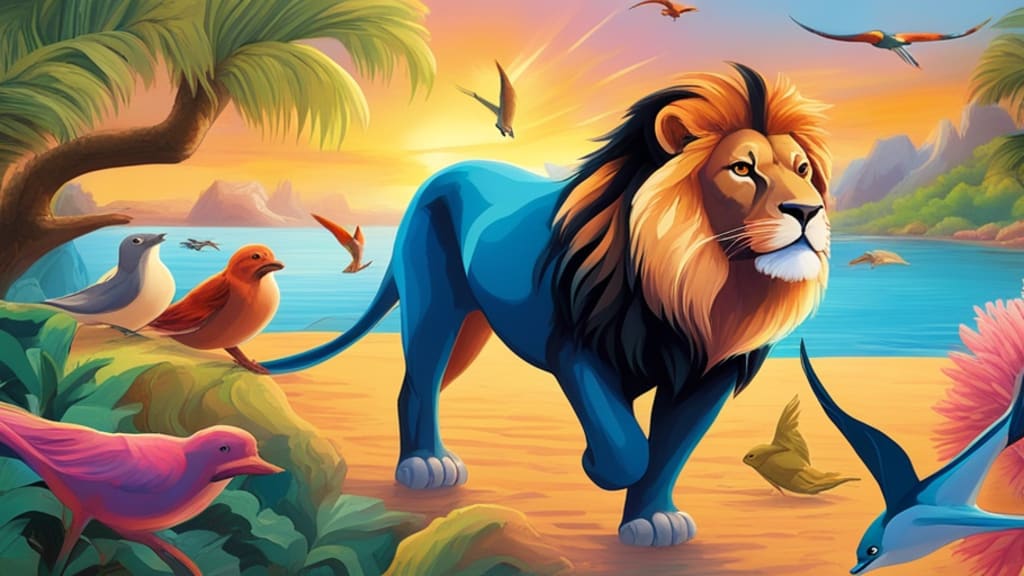Content warning
This story may contain sensitive material or discuss topics that some readers may find distressing. Reader discretion is advised. The views and opinions expressed in this story are those of the author and do not necessarily reflect the official policy or position of Vocal.
Wild Wonders: Exploring the Animal Kingdom
Exploring the Wonders of the Animal Kingdom An In-Depth Overview

Hello readers, I hope you're all doing well today. In this article, we will be diving into the fascinating world of the animal kingdom, exploring its wonders and providing an in-depth overview of the various species that inhabit our planet.
WATCH IT IN VIDEO
Feel free to explore the various sections and learn more about the incredible diversity that exists within the animal kingdom. So, without further ado, let's dive in!
WATCH IT IN VIDEO
Introduction to the Animal Kingdom
WATCH IT IN VIDEO
The animal kingdom, also known as the kingdom Animalia, is a diverse group of organisms that includes all animals. Animals are multicellular, eukaryotic organisms that have cells with a distinct nucleus. They are heterotrophic, meaning they obtain their energy by consuming other organisms. There are millions of different animal species, ranging from tiny insects to large mammals.
WATCH IT IN VIDEO
Animals are classified into various groups based on their characteristics and evolutionary relationships. The animal kingdom is divided into several phyla, including Chordata (which includes vertebrates like mammals, birds, and fish), Arthropoda (which includes insects and crustaceans), and Mollusca (which includes snails and squids), among others.
WATCH IT IN VIDEO
Understanding the classification and characteristics of animals is essential for studying their behavior, ecology, and evolution.
WATCH IT IN VIDEO
Mammals - The Diverse Class
WATCH IT IN VIDEO
Mammals are a diverse class of animals that belong to the phylum Chordata. They are characterized by their ability to nurse their young with milk produced by mammary glands. Mammals can be found in various habitats, ranging from the depths of the oceans to the highest mountain ranges.
WATCH IT IN VIDEO
Mammals in Different Environments
WATCH IT IN VIDEO
Mammals have adapted to thrive in different environments. In the oceans, we can find marine mammals such as whales, dolphins, and seals. These animals have streamlined bodies and are well-adapted to living in water. On land, we have a wide variety of mammals, including herbivores like elephants and giraffes, carnivores like lions and tigers, and omnivores like bears and humans.
WATCH IT IN VIDEO
Diversity in Mammalian Species
WATCH IT IN VIDEO
The class Mammalia is incredibly diverse, consisting of over 6,000 species. Mammals come in all shapes and sizes, ranging from tiny bats to massive elephants. They also exhibit a wide range of behaviors and adaptations. For example, some mammals, like bats and dolphins, have developed the ability to echolocate, while others, like primates, have highly developed brains and complex social structures.
WATCH IT IN VIDEO
Mammals and Their Unique Characteristics
WATCH IT IN VIDEO
Mammals possess several unique characteristics that set them apart from other animals. One of these is the presence of hair or fur, which helps to regulate body temperature. Mammals also have specialized teeth for different diets, ranging from sharp incisors for tearing meat to flat molars for grinding plant material. Additionally, mammals have a diaphragm, a muscle that separates the chest cavity from the abdominal cavity and aids in breathing.
WATCH IT IN VIDEO
Birds - The Feathered Friends
WATCH IT IN VIDEO
Birds are fascinating creatures that have captivated humans for centuries. With their beautiful feathers and melodious songs, they have become beloved companions in our lives. Here are some interesting facts about birds:
WATCH IT IN VIDEO
Birds are warm-blooded vertebrates.
WATCH IT IN VIDEO
There are over 10,000 species of birds in the world.
WATCH IT IN VIDEO
Some birds can fly while others are flightless.
WATCH IT IN VIDEO
Birds have beaks, wings, and feathers.
WATCH IT IN VIDEO
They lay eggs and take care of their young.
WATCH IT IN VIDEO
Birds have hollow bones, which make them lightweight for flying.
WATCH IT IN VIDEO
They come in various sizes, from the tiny hummingbird to the majestic eagle.
WATCH IT IN VIDEO
Birds play a vital role in pollination and seed dispersal.
WATCH IT IN VIDEO
They have unique migration patterns, traveling long distances during certain seasons.
WATCH IT IN VIDEO
These are just a few of the many incredible aspects of birds. They are truly remarkable creatures that deserve our admiration and protection. So next time you spot a bird in your backyard or hear its delightful song, take a moment to appreciate the beauty and wonder of our feathered friends.Reptiles and Amphibians - Cold-Blooded Wonders
WATCH IT IN VIDEO
Reptiles and amphibians are fascinating creatures that belong to the class of cold-blooded animals. They are marvels of nature, adapted to survive in various environments around the world.
WATCH IT IN VIDEO
Reptiles, such as snakes, lizards, and turtles, are known for their scaly skin and ability to lay amniotic eggs. They rely on external heat sources to regulate their body temperature and are often found basking in the sun to warm up. Amphibians, on the other hand, include frogs, toads, and salamanders. They have smooth, moist skin and undergo metamorphosis, starting their lives as aquatic larvae and transitioning into terrestrial adults.
WATCH IT IN VIDEO
Fish - The Aquatic World
WATCH IT IN VIDEO
Fish are fascinating creatures that inhabit the aquatic world. They are a diverse group of animals that come in various shapes, sizes, and colors. From the smallest guppy to the largest whale shark, fish have adapted to survive and thrive in different aquatic environments.
WATCH IT IN VIDEO
One interesting fact about fish is that they breathe through gills. Gills are specialized organs that extract oxygen from water, allowing fish to "breathe" underwater. This is different from how humans and other mammals breathe, as we rely on lungs to extract oxygen from the air. Fish also have a streamlined body shape and fins that help them swim efficiently through water.
WATCH IT IN VIDEO
About the Creator
Mohamd Elnagar
Professional writers and content creators
I am an accomplished wordsmith who loves to create interesting and thought-provoking content.With 30 years of experience in the writing industry.
Enjoyed the story? Support the Creator.
Subscribe for free to receive all their stories in your feed. You could also pledge your support or give them a one-off tip, letting them know you appreciate their work.






Comments
There are no comments for this story
Be the first to respond and start the conversation.